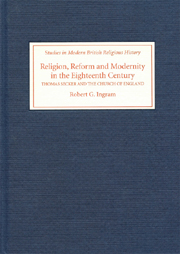Book contents
- Frontmatter
- Contents
- Dedication
- Preface
- Abbreviations
- 1 ‘Efforts at Amendment’
- 2 Becoming an Anglican
- 3 Becoming an Insider
- 4 The Church and the Enlightenment
- 5 The Church and the Parishioners
- 6 The Church and the State
- 7 The Church and America
- 8 The Church and Churches Abroad
- Epilogue
- Bibliography
- Index
- Previously published volumes in this series
Epilogue
Published online by Cambridge University Press: 12 September 2012
- Frontmatter
- Contents
- Dedication
- Preface
- Abbreviations
- 1 ‘Efforts at Amendment’
- 2 Becoming an Anglican
- 3 Becoming an Insider
- 4 The Church and the Enlightenment
- 5 The Church and the Parishioners
- 6 The Church and the State
- 7 The Church and America
- 8 The Church and Churches Abroad
- Epilogue
- Bibliography
- Index
- Previously published volumes in this series
Summary
‘He is indeed to Us Ultimus Romanorum, the last of those Great and Good Men with whom we have been connected,’ the earl of Hardwicke wrote to his brother on learning of Thomas Secker's death. The end came in the late summer of 1768. Secker had spent the entire year in agonizing pain, suffering from what his physicians thought was rheumatism. Though Secker tried to hide his discomfort from family and friends, he confided to his doctors that ‘the Pains were so excruciating that unless some Relief could be procured, he thought it would be impossible for human Nature to support them long’. On Sunday evening, 31 July, he lay on a couch in Lambeth Palace's picture gallery, attended only by his two doctors and a servant. Around eight o'clock, he ‘found himself suddenly sick, called for a Bason, was raised from the Couch, and attempted to retch, but could not; at that very instant, he felt a most dreadful Pain in his right Thigh, and cried out most lamentably’. His right femur, eaten away by cancer, an autopsy would later reveal, had snapped in half. He died three days later in an opiate haze.
Secker left behind explicit instructions for his funeral to be ‘as private as possible’, and the only people admitted into St Mary's, Lambeth, on 9 August for it were family members, chaplains, servants, and a very few others. Beilby Porteus performed the service, after which the large elm coffin containing Secker's corpse was taken outside and placed in an unmarked leaden vault within the wall of an arched hallway between the parish church and the archiepiscopal palace.
- Type
- Chapter
- Information
- Religion, Reform and Modernity in the Eighteenth CenturyThomas Secker and the Church of England, pp. 283 - 289Publisher: Boydell & BrewerPrint publication year: 2007



